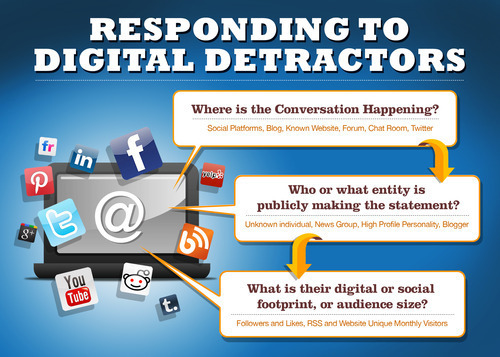31
Jul
Defending Your Brand Against Digital Detractors on Twitter and Facebook
by jon tilton,
published by pr news press “crisis management guidebook”
Your company’s Facebook page has recently experienced unfavorable posts by detractors and the comments are starting to take a life of their own in the Twitterverse. You have been instructed by your c-suite to formally respond on the company’s Twitter and Facebook page where thousands, if not millions, of your followers will see. The stakes are high and ramifications of one erroneous response could last a lifetime.
What do you do?
Regardless of the validity of the unfavorable comments, an overwhelming majority of your fans and followers are most likely not up to speed with the situation. At all costs, avoid feeding the story and giving it more credibility than it deserves by officially “reacting” to it, especially on social. It is imperative that the company does not engage officially in dialogue or respond to allegations with individual detractors that are not credible. Prominent blogs, mainstream newsmakers, media groups (e.g., USA TODAY, NEW YORK TIMES, WALL STREET JOURNAL or WASHINGTON POST) are certainly a different matter. By engaging with random sock puppet handles and non-credible detractors the company will:
- Bolster the detractors credibility;
- Add energy to the allegations they are making; and,
- Appear defensive in nature by dipping into the fray with a rogue digital personality that is confined to a niche community.
Remember the strength and value of your official voice and avoid “punching downward” in ways that will only build a story where one does not actually exist.
That said, inaccurate information and distortions should be corrected whenever and wherever found. This should be done through a third-party individual, or group, who is a knowledgeable friend of the company, empowered with the right messages and materials to counter bloggers or Twitter comments with facts and substantiated data or relevant links to redirect the readers, and ideally shape the conversation in a favorable direction.
We’ve fleshed out an escalation engagement plan. Essentially, we’ve broken this down into suggested considerations and guidelines to help determine your proportional response activity and level of engagement. Each instance will likely require its own judgment call, but here are some initial thoughts on specific criteria to determine whether or not your company should respond officially:
Where is the statement taking place and is it spreading (and to where)?
- Social platform (Facebook)
- Blog
- Mainstream media website
- Twitter (micro-blog)
Who or what entity is publicly making the statement?
- Individual
- News group
- High-profile reporter
- Blogger
- Sock puppet Twitter handle
What is the credibility – nature and size of their audience or social graph?
- Do they have a national following with thousands of unique monthly viewers
of their website or blog
- Small niche blog with limited followers
- Well-known online opinion elite whose identity is known
- Unknown identity/shadow Twitter “sock-puppet” account
NO Engagement
Individual rogue Twitter handle
Unknown identity (sock-puppet account)
Limited followers
Engagement
Well-known personality or news group
Large national following
If engagement – how to respond:
Depending on the allegation, you should approach this on a case-by-case basis. Think about where the comments are taking place and decide if it makes sense to respond in kind on that platform.
If engagement, who responds?
Throughout most social media platforms where we find writers with little to no credibility, we suggest having a friendly third-party who is informed on messaging and is equipped with factual information and links to correct the record on that site or blog alone. This person should contain responses to where they are occurring only. If it’s a chat room or comments section of a blog or post, think about a simple one-sentence post directing interested bystanders to a blog page, via bit.ly, connected to your corporate, or organizations, web site.
Minimal third-party engagement
Large credible Twitter account – find a credible organization or advocate that has a substantial social media presence and have him or her tweet to the detractors followers or utilize a specific hash-tag that could say “if you want the truth go to [bit.ly] blog for more information.”
More credible
Matching appropriate voice with the nature of the allegation/storyline with the appropriate level company staff person (smaller outlets – regular spokesperson, major outlets may justify c-suite involvement). We would advise against looking to legal action without careful consideration. Again, the asymmetrical nature of your organization against an individual is more often than not going to look like a David vs. Goliath situation, where you hand them a much bigger megaphone, create a much bigger story, and likely will come across as an overly-defensive bully.
To help mitigate, time should be given to stockpiling current positive material, data, messengers, and building a network of credible third-party digital influencers, and pushing those out in a sustained, aggressive way to elevate your positive message in search and push down negative commentary. Stay on offense and tell your story.
Furthermore, we recommend utilizing a holding statement that has been approved by internal business partners. We suggest modifying for specific social and micro-blogging platforms—Twitter only allows 140 characters. That said, when ready to respond to credible sources, consider officially posting on your company website and redirect, via bit.ly link, to your statement from your social presences. Or have a friendly third-party post on Twitter and re-direct to the company website on the company’s behalf.
HOLDING STATEMENT:
Have a holding statement of no more than two paragraphs; link to information to substantiate your point-of-view, and stick to it. Do not appear reactive, but focus on the overall mission and core-values of the company. It is imperative to not allow the peripheral noise distract the company from staying on course. Stick to your position and be the voice of reason for your c-suite.


Jon Tilton
published by pr news press “crisis management guidebook”